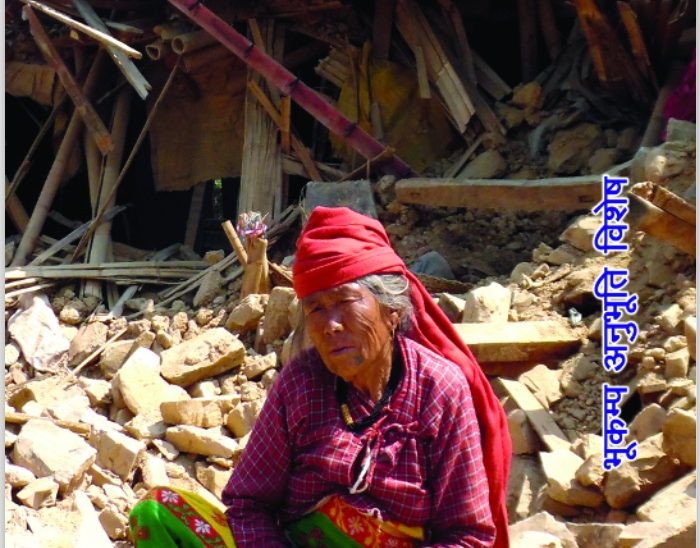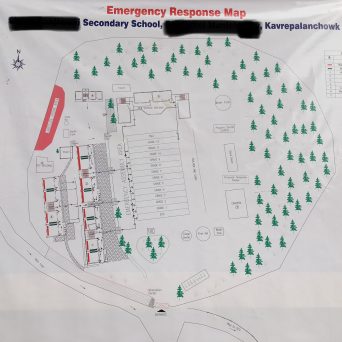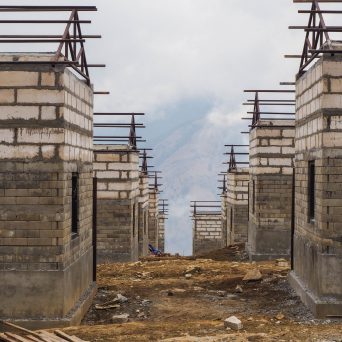
The Nepali-language poetry of the 2015 earthquakes and their aftermath, by Michael Hutt
In their widely-cited analysis of post-disaster politics, Mark Pelling and Kathleen Dill have argued that ‘the dominance of geophysical science and of positivistic social sciences in disaster management has maintained both the exceptionalism and apolitical construction of disasters’ (2010:23); similarly, Albala-Bertrand has observed that ‘most writings on disaster response overlook or disregard the endogenous response’ (1993:23).
The validity of this observation will be borne out by a glance at the contents pages of the leading journals of the emerging field of Disaster Studies. More often than not, the primary concerns of articles that focus on cases from ‘developing world countries’ are the practicalities of disaster management. Emic perspectives are more commonly found in analyses of disaster aftermaths in the global North than in analyses of disaster aftermaths in the global South.
Several notable surveys have appeared of the political outcomes of disasters in different places and different times. For instance, Pelling and Dill discuss the potential for a disaster to provide either a ‘critical juncture’ (a contestation of established political, economic and cultural power) or an ‘accelerated status quo’ (a successful concentration of that power) and ask whether it is possible for us to identify ‘tipping points, critical historical moments or broader influences on systems (internal and external) that determine the direction and significance of change’ (2010:22). But they do not really tell us what a ‘tipping point’ might look like from an emic, ‘endogenous’ perspective.
I suggest that any model that emerges from research into disasters worldwide and offers to help us to navigate the contours of the political, social and cultural aftermaths of those disasters will be simplistic if the studies of specific disaster aftermaths upon which it has drawn are not proportionately representative of all disasters in all places over time, and do not go beyond a certain minimum level of engagement with the public discourse in the countries where the disasters have taken place. As a long term student of Nepali language literature, I decided that I would use the creative literature published in Nepal during the early months of the aftermath as a lens through which to view this period. Given the sheer quantity of close reading required, I decided to focus in the first instance on poetry written in the Nepali language. Poetry was chosen over other literary genres because poems and lyrics are produced more quickly and spontaneously than other literary genres and are likely to appear in the public sphere, whether on paper or online, more immediately.
Over the winter of 2017-18 I collected and read as much as I could of the Nepali language poetry of the aftermath, drawing mainly on the special earthquake editions (bhukampa visheshank) of the leading Nepali literary journals. I eventually assembled a corpus of material consisting of 291 compositions by 256 different poets. My analysis of this material revealed the prevalence of seven dominant themes:
- generalised statements of anguish at the destruction and loss of life, concluding with expressions of determination to rebuild;
- narrative witness accounts of specific instances of loss and destruction;
- arguments that shortcomings in Nepali society itself should be blamed for the disaster;
- anthropomorphic representations of and conversations with the earthquake;
- representations of the earthquake as a socially unifying and levelling force;
- accounts of the unequal distribution of loss;
- politically charged articulations of anger at the government’s response and distrust of the ruling elite.
Any attempt to represent this body of poetry as the expression of a wider public mood would be severely compromised by the fact that its authorship is not representative of the population at large. As is almost always the case in Nepali-language literature, Khas-Arya male authors are numerically dominant, and much of this poetry emanated from Kathmandu rather than from the more severely affected hill districts. Yet I still believe that these are voices to which we might usefully attend if we wish to understand Nepali perceptions of the sociological and political impact of the 2015 earthquakes more fully. While much that happens in Nepal is donor-driven, and often English medium-based, these poems were written for a readership that extends far beyond the urban elite and the inhabitants of the NGO and development world. They therefore represent a part of the Nepali ‘endogenous response’ to which limited attention has been paid to date.
References:
Albala-Bertrand, J. M. 1993. Political Economy of Large Natural Disasters. With Special Reference to Developing Countries. Oxford: Clarendon Press.
Pelling, Mark and Kathleen Dill 2010. ‘Disaster politics: tipping points for change in the adaptation of socio-political regimes’ Progress in Human Geography 34(1): 21-37.
Illustration:
The cover of volume 166 of the monthly Nepali literary journal Shabdankur, an ‘Earthquake Experience Special Issue’ published in Saun 2072 (July-August 2015).



